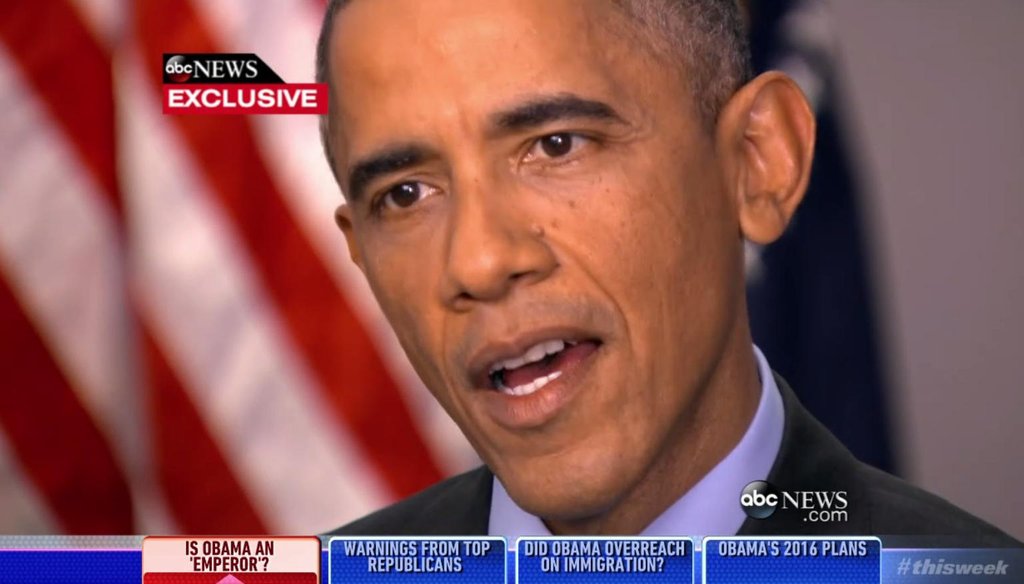Stand up for the facts!
Our only agenda is to publish the truth so you can be an informed participant in democracy.
We need your help.
I would like to contribute

President Barack Obama talked about his immigration action and unrest in Ferguson, Mo., in an interview with ABC "This Week" host George Stephanopoulos on Nov. 23, 2014.
As Republicans decried his actions across the country and its cable networks, President Barack Obama used an interview with ABC News to defend his decision not to deport more than 4 million immigrants living in the country illegally.
Republican officials in at least five states from Wisconsin to Texas are poised to launch a legal barrage following Obama’s unilateral immigration move, but Obama says the law is on his side.
Fresh off a Friday speech in Las Vegas, Obama noted he is far from the first president to selectively implement immigration law in an interview that aired Sunday with ABC This Week’s George Stephanopoulos.
"Do you have the right to make that decision on your own?" Stephanopoulos asked.
"Absolutely," Obama replied. "If you look, every president -- Democrat and Republican -- over decades has done the same thing as I mentioned in my remarks today."
Sign up for PolitiFact texts
His response is similar to a line from his Thursday address at the White House, when he likened his executive action to "the kinds of actions taken by every single Republican president and every single Democratic president for the past half century." That claim rates Half True.
Obama’s claim has some merit. A report from the American Immigration Council, a pro-immigration group, cites 39 examples since 1956 in which a president granted "temporary immigration relief to one or more groups in need of assistance." The group found at least one executive action from each president since (and including) President Dwight D. Eisenhower that either added exemptions to immigration law, extended protections to certain classes or decided what categories of people will be subject to enforcement.
The single largest action before now came from President George H.W. Bush. In 1990 he forestalled deportations for an estimated 1.5 million undocumented immigrants after passage of a 1986 law that granted legal status for many, but not all, immigrants living here without permission. President Ronald Reagan took similar action, affecting about 100,000 families.
White House officials said other smaller actions included reprieves for Cubans in the 1960s, Southeast Asians in the 1970s and Nicaraguans in the 1980s.
But setting aside the actions of Bush and Reagan, Obama’s critics say what other presidents have done differs in significant ways.
"The list reads like a study guide of post-war foreign crises," said Mark Krikorian, executive director of the Center for Immigration Studies, which favors reduced immigration.
Obama’s plan is easily the biggest such action ever taken by a president, at least in raw numbers, with between 4 million and 5 million potential beneficiaries. Bush’s action offers the clearest parallel as the second-largest action, with a similar percentage of the undocumented population potentially affected, no specific nationality being targeted and allowing beneficiaries to qualify for a work permit.
Still, that appears to be the exception rather than the rule. Most of the actions taken by prior presidents were more limited in size, scope and benefits. So, even if you accept that the 1990 action is a close precedent, that’s a much more limited claim than the one Obama made.
High-profile Republicans continued to criticize Obama on other shows, with former GOP presidential candidate Rick Santorum saying the decision "slapped the face" of lawmakers. On CNN’s State of the Union, Santorum called on the GOP to adopt an "immigration control" platform that favored legal, working Americans to counter an immigration wave.
"The last 20 years have been the largest wave of immigration in the history of this country," Santorum said. "There are more people living in this country who were not born here than at anytime in the history of the country. And what the president is saying is, ‘We need more.’ And working men and women are saying, ‘Hold on, what about us?’ "
Santorum is correct in terms of the raw numbers of foreign born, but experts say it’s not the best measure to use when comparing foreign-born populations over the years. We rate it Half True.
As of 2012, the most recent year for which the Census Bureau has data, the foreign-born population of the United States was about 40 million, which factors in the estimated number of immigrants in the country illegally. In terms of sheer numbers, that’s the highest on record.
However, the total U.S. population has grown significantly in the past 160 years. Foreign-born residents made up 12.9 percent of the total U.S. population in 2010. In this respect, today’s foreign-born population is not the highest it’s ever been -- in fact, it was higher from 1860 through the 1920s. That said, the 2010 percentage is the highest since 1920.
The following chart, taken from a Census slide presentation, shows the growth of the foreign-born population from 1850 to 2010 in pink bars. The blue line shows their share of the country’s population.
Several experts said comparing the percentage of foreign-born residents against the total population better reflects the country’s ability to accommodate immigrants.
"As a historian, there is no reason whatsoever to focus on the absolute number over the percentage," said Kenyon Zimmer, an immigration historian at the University of Texas Arlington. "The absolute number tells us nothing useful about the impact of immigration on the United States -- an impact that is, today, less than it was during the age of ‘mass immigration’ around the turn of the (20th) century."
PunditFact staff writer Jon Greenberg contributed to this report.
Our Sources
See fact-checks.














































